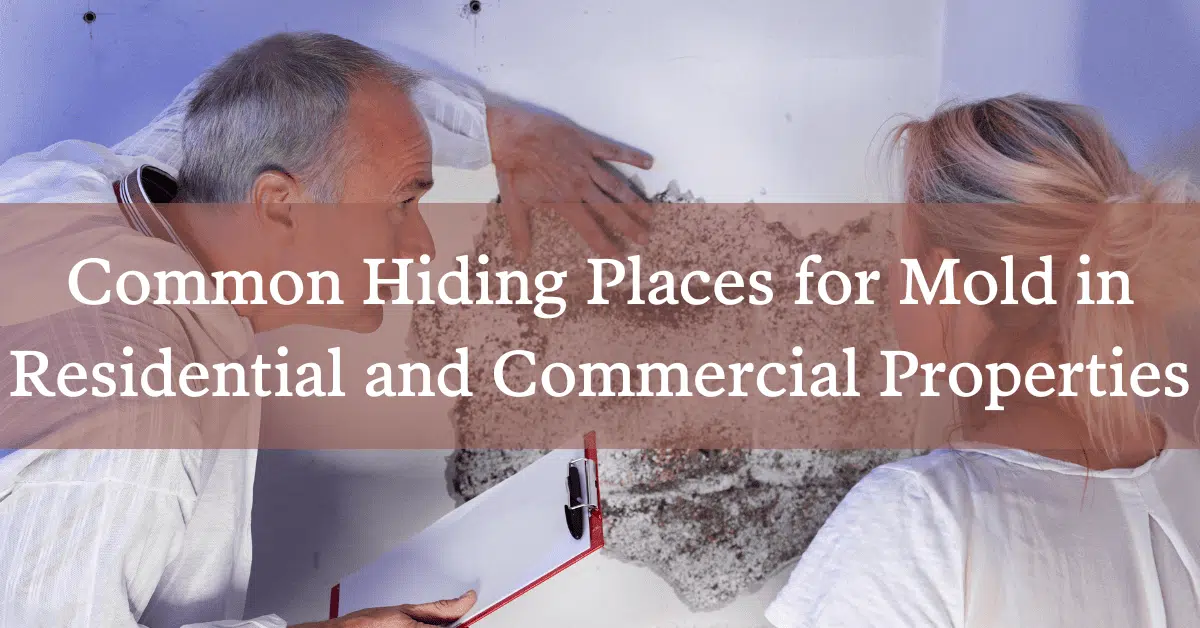Mold thrives in damp and humid environments. But how to find mold? Even if one is armed with this knowledge, it can still be challenging to detect. Whether in residential or commercial properties, identifying the common hiding places for mold is crucial in preventing mold from growing and spreading and posing a potential health hazard.
Here are some common areas in your home or business where mold can take root, as well as tips on staying vigilant and maintaining a mold-free environment.
Bathrooms
- Shower curtains and grout lines: Moisture from showers and baths can accumulate on shower curtains and within grout lines, creating an ideal environment for mold to grow.
- Under the sink: Leaks or drips in sink plumbing can lead to mold growth in the cabinet below.
- Ventilation: Improperly vented bathrooms may allow moisture to accumulate in the walls or ceilings. This can lead to hidden mold.
Kitchens
- Refrigerator drip pans: The drip pan at the bottom of refrigerators collects moisture and can become a breeding ground for mold.
- Beneath appliances: Any spills or leaks beneath appliances, such as dishwashers or refrigerators, can promote mold growth.
- Kitchen sink and faucets: If not adequately dried after use, mold can begin to grow around the sink and faucet area.
Basements and Crawl Spaces
- Foundation cracks: Moisture seeping through foundation cracks can lead to mold growth in basement walls.
- Mold on stored items: It’s common for mold to develop on cardboard boxes, old furniture, or textiles stored in damp basements or crawl spaces.
- Humidifiers: Improperly maintained or leaking humidifiers in basements can create a humid environment suitable for mold growth.
Attics
- Roof leaks: Leaks in the roof can lead to moisture accumulation and hidden mold growth in attic spaces.
- Poor ventilation: Inadequate attic ventilation can trap moisture, encouraging mold formation.
HVAC Systems
- Air ducts: Dust, dirt, and moisture in HVAC air ducts can provide an ideal environment for mold to thrive.
- Condensation trays: Moisture from condensation trays in air conditioning units can lead to mold growth if not properly drained.
Laundry Rooms
- Washing machine: Moisture buildup inside and around washing machines can lead to mold growth.
- Dryer vents: Clogged or improperly vented dryer vents can trap moisture, providing a breeding ground for mold.
Wall Cavities
- Leaky pipes: Water leaks within wall cavities can result in hidden mold growth behind the wall.
Carpets and Upholstery
- Wet or damp carpets: Spills, leaks, or flooding can lead to mold growth on carpets and padding.
- Mold on upholstered furniture: Moisture from spills or humidity can encourage mold growth on fabric-covered furniture.
Office Spaces
- Roof leaks: Like residential properties, roof leaks can lead to hidden mold growth in office buildings.
- Poor ventilation: Inadequate airflow and ventilation in enclosed office spaces can contribute to mold formation.
Awareness of common hiding places for mold is the first step in protecting residential and commercial properties against its destructive impact. Regular inspections, prompt attention to leaks, proper ventilation, and maintaining a dry environment are essential in preventing mold growth. By staying vigilant and proactive, you can ensure a healthy and mold-free living and working environment for everyone.
Are you located in the greater Orlando, Florida, area? Our expert mold specialists are ready to tackle your mold problem. Contact us today!


